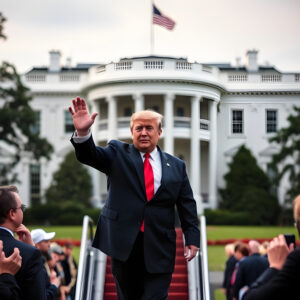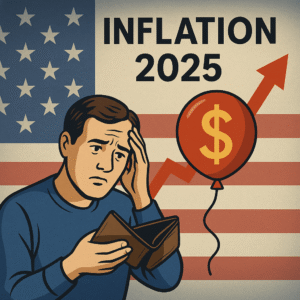Starting November 1, 2025, the U.S. will apply a new 100% tariff on many Chinese imports, including technology products, machinery, and important raw materials.
This is one of the biggest trade moves in recent years and marks a serious escalation in the ongoing U.S.–China trade tensions. Businesses that rely on Chinese imports will face higher costs, and global supply chains may be disrupted as companies adjust to the new rules.
Why This Matters Now for Global Trade & Markets
This trade move affects more than just tariffs — it creates uncertainty across global markets. Companies may delay purchases or production, investors may shift money away from risky assets, and markets like stocks, commodities, and crypto can become volatile. For crypto specifically, rising geopolitical risk often leads to short-term price swings, as investors look for safer assets or adjust their positions. Overall, the new tariffs signal a period of heightened caution for anyone involved in international trade or financial markets.
Key Measures Announced
100% Tariff on Chinese Imports and Export Controls on Tech/Rare Earths
The U.S. will impose a 100% tariff on a wide range of Chinese goods, including technology products and rare-earth materials critical for electronics and renewable energy. This measure aims to reduce reliance on China but could raise costs for manufacturers and affect global supply chains.
25% Tariff on Medium & Heavy Duty Truck Imports Starting Nov 1
Starting November 1, 2025, the U.S. will also apply a 25% tariff on medium and heavy-duty trucks imported from China. This will impact companies in the transportation and logistics sectors, potentially increasing shipping and production costs.
Other Sector-Specific Duties and Trade Restrictions
Additional measures target specific sectors such as electronics, solar panels, and machinery. These sector-specific duties and trade restrictions are meant to protect domestic industries but may create short-term disruptions in global trade and investor sentiment, adding to overall market uncertainty.
Immediate Market & Trade Reactions
How Global Markets Responded to the Announcement
The announcement of new U.S. tariffs triggered sharp reactions across global markets. Stock indices in the U.S., Asia, and Europe fell as investors feared the economic impact of higher trade barriers. Commodities like oil and metals saw increased volatility due to potential supply disruptions. Cryptocurrencies also reacted, with Bitcoin and major altcoins experiencing sudden price swings as risk-off sentiment spread among investors. Traders rushed to adjust positions, and leveraged accounts faced liquidations, amplifying short-term volatility.
Response from China and Other Major Trade Partners
China responded strongly, signaling potential retaliatory measures and emphasizing the need for negotiations. Other major trade partners, including the EU and Japan, expressed concerns over the escalation, warning that global trade could slow down if tensions continue. These reactions highlighted that the tariff move is not just a bilateral issue but has wider implications for global trade stability.
Impact on Supply Chains and Multinational Companies
Multinational companies with operations in both the U.S. and China faced immediate challenges. Higher tariffs increase import costs, disrupt manufacturing schedules, and force some businesses to rethink supply chains or move production to other regions. Logistics and shipping costs are also likely to rise. The uncertainty caused by these measures can delay investment decisions, affect profit margins, and create short-term economic turbulence while markets adjust to the new trade environment.
Strategic Drivers Behind the Move
Rare Earths, Critical Minerals & National Security Angle
One key reason for the new tariffs is control over rare earths and critical minerals, which are essential for electronics, renewable energy, and defense technology. The U.S. aims to secure supply chains for strategic industries and reduce dependence on China, ensuring national security and technological competitiveness in the long term.
Shift in U.S. Trade Policy from Free-Trade Towards Protectionism
The tariffs reflect a broader shift in U.S. trade policy from global free-trade principles toward protectionism. By raising tariffs on imports, the U.S. seeks to protect domestic industries and incentivize local production, even if it risks short-term market disruptions. This marks a clear policy direction emphasizing economic self-reliance over global integration.
Geopolitical Context: U.S.–China Tensions & APEC Summit Outcomes
The move is also influenced by ongoing geopolitical tensions between the U.S. and China, including disputes over technology, military presence, and regional influence. Outcomes from recent APEC summit discussions have reinforced these strategic priorities, pushing the U.S. to take a firmer stance on trade. The tariffs serve both as an economic measure and a geopolitical signal to China and other global partners about U.S. policy intentions.
Risks & Downside Scenarios
Escalation of Trade War Leading to Broader Global Slowdown
If tensions between the U.S. and China continue to escalate, global markets could face a widespread economic slowdown. Higher tariffs and prolonged uncertainty may reduce international trade, limit corporate investment, and weaken consumer confidence, creating risk-off conditions across equities, commodities, and crypto markets.
Retaliation by China and Others Affecting U.S. Exporters
China and other trade partners could respond with retaliatory tariffs or export restrictions, directly impacting U.S. companies that rely on foreign markets. This could reduce sales, hurt profits, and increase costs for exporters, further pressuring financial markets and investor sentiment.
Supply-Chain Disruptions and Inflationary Pressures
Higher tariffs and restrictions may disrupt supply chains, making raw materials and components more expensive. Companies may pass these costs to consumers, contributing to inflationary pressures. In addition, delays in production and shipping can affect multinational companies, potentially slowing economic growth and creating short- to medium-term market volatility.
Possible Outcomes & Scenario Planning
Bull Scenario: Deal is Struck, Tariffs Act as Leverage, Markets Calm
In the bullish scenario, negotiations between the U.S. and China lead to a partial or full trade deal, and the tariffs are seen as a temporary leverage tool. Markets quickly stabilize as investor confidence returns, supply chains adjust, and both traditional and crypto markets recover. Businesses benefit from clarity and predictability, and short-term volatility subsides.
Base Scenario: Prolonged Tension, Moderate Disruption, Gradual Adjustment
Here, trade tensions persist without immediate resolution. Markets experience moderate volatility, with occasional price swings in stocks, commodities, and crypto. Companies gradually adapt by diversifying supply chains or adjusting production schedules. While disruptions remain, economies adjust over time, leading to a slow but steady normalization in global trade and market activity.
Bear Scenario: Widespread Retaliation, Supply-Chain Shock, Recession Risk
In the worst-case scenario, retaliatory measures by China and other countries escalate, causing major supply-chain disruptions and significant increases in costs. Prolonged uncertainty may trigger a global recession, with falling exports, weaker corporate earnings, and heightened market panic. Crypto markets could face sharp declines due to risk-off sentiment, and investors may seek safety in gold, cash, or other traditional hedges.
What to Monitor Next
Upcoming Meetings and Trade Talks Between U.S. & China, Asia‑Pacific Forums
Investors and businesses should watch for high-level meetings between U.S. and Chinese officials, as well as discussions at Asia-Pacific economic forums. Any signals of negotiation, compromise, or easing of tariffs could quickly influence market sentiment and prompt rallies in stocks, commodities, and crypto.
Monthly/Quarterly Trade Data and Tariff Collection Figures
Trade and tariff statistics will provide insight into how the new measures are impacting imports, exports, and overall trade flow. Rising tariff collections or slowing imports may signal supply-chain stress and broader economic effects, helping investors anticipate market reactions.
Corporate Earnings and Supply-Chain Disclosures Affected by Tariffs
Public companies will report the financial impact of higher tariffs in their quarterly earnings. Supply-chain disruptions, increased costs, or changes in production plans can affect profitability and stock prices. Monitoring these disclosures can help investors gauge real-world effects of the trade measures and adjust their portfolios accordingly.
Investor/Business Implications
For U.S. Importers/Exporters: Cost Management and Hedging Strategies
U.S. companies dealing with Chinese imports will face higher costs due to tariffs. Businesses may need to adjust pricing, renegotiate supplier contracts, or find alternative suppliers. Hedging strategies such as forward contracts, options, or currency hedges can help mitigate financial risk and maintain profitability amid uncertainty.
For Global Investors: Sector Shifts, Safe-Havens, and Risk Exposure
Investors worldwide may need to reallocate portfolios as certain sectors, like technology and manufacturing, face higher risk from tariffs. Safe-haven assets, including gold, government bonds, or even Bitcoin, could become more attractive. Understanding sector exposure and adjusting risk levels is crucial during periods of geopolitical tension.
For Smaller Businesses: Case Studies of Firms Already Impacted
Smaller companies often feel trade shocks more acutely. Some firms have already delayed shipments, shifted production overseas, or increased prices in response to earlier tariff rounds. These examples highlight the importance of agility, financial planning, and diversification for smaller businesses operating in global markets affected by trade disputes.
Conclusion & Outlook
Summary of How Trump’s Trade Rules Could Reshape Global Trade by End‑2025
Trump’s new trade rules, including 100% tariffs on key Chinese imports and additional sector-specific measures, are likely to reshape global trade dynamics by the end of 2025. Companies may diversify supply chains, shift production to other countries, and adjust pricing strategies. Global markets could experience higher volatility in the short term, while industries heavily reliant on Chinese imports may face cost pressures. Overall, the rules signal a more protectionist U.S. trade policy, influencing investment decisions, international trade flows, and the role of alternative markets like cryptocurrencies.
Key Indicators That Will Reveal if This Is a Tactical Move or Structural Shift
To determine whether these measures are temporary tactics or a long-term structural shift, investors and businesses should monitor:
-
Trade negotiations and high-level meetings between the U.S. and China for signs of easing or compromise.
-
Monthly and quarterly trade data to see if imports, exports, and tariff collections stabilize or decline.
-
Corporate earnings and supply-chain disclosures to gauge the financial impact on businesses.
-
Market reactions across equities, commodities, and crypto for patterns of sustained volatility or recovery.
These indicators will clarify whether the trade rules are a short-term leverage tool or represent a permanent shift toward U.S. protectionism affecting global trade for years to come.
FAQs
1. What are the main components of Trump’s new trade rules?
The rules include a 100% tariff on key Chinese imports, 25% tariff on medium and heavy-duty trucks, and sector-specific restrictions on technology, machinery, and rare-earth materials.
2. How have global markets reacted so far?
Markets experienced sharp volatility. Stocks, commodities, and cryptocurrencies saw price swings, while investors adopted a risk-off approach, moving funds into safer assets.
3. What risks do these trade measures pose to businesses?
Risks include higher import costs, supply-chain disruptions, reduced profit margins, and potential retaliation from China or other trade partners, affecting U.S. exporters and multinational companies.
4. How can investors manage exposure during this period?
Investors should diversify portfolios, consider safe-haven assets, monitor market trends closely, and use hedging tools such as options or stablecoins to reduce short-term risk.
5. Could these tariffs be temporary or a long-term structural shift?
It depends on trade negotiations, policy signals, and economic impact. If talks between the U.S. and China lead to partial easing, the move may be tactical. Persistent tensions or further escalation could signal a long-term shift toward protectionism.








